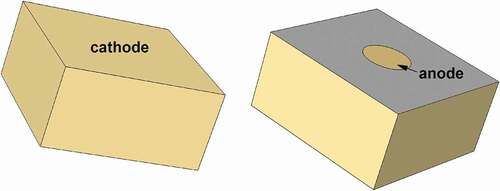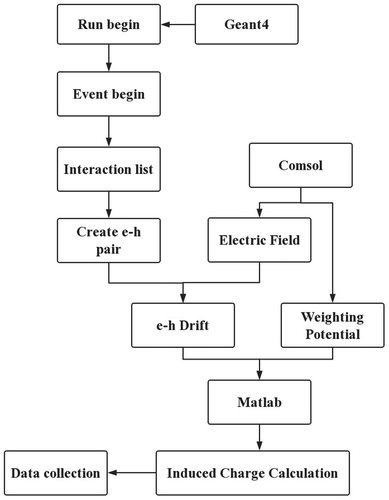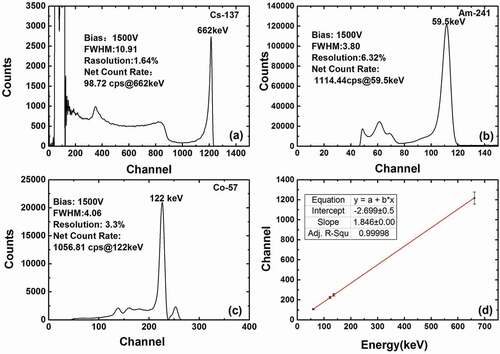 ?Mathematical formulae have been encoded as MathML and are displayed in this HTML version using MathJax in order to improve their display. Uncheck the box to turn MathJax off. This feature requires Javascript. Click on a formula to zoom.
?Mathematical formulae have been encoded as MathML and are displayed in this HTML version using MathJax in order to improve their display. Uncheck the box to turn MathJax off. This feature requires Javascript. Click on a formula to zoom.ABSTRACT
Quasi-hemispherical CdZnTe detector was manufactured successfully to fully understand the performance in the mixed gamma–neutron detection field. Together with the software of COMSOL, Geant4, and Matlab, the detector structure has been optimized. The CdZnTe detector performs good energy resolutions for 241Am, 57Co, and 137Cs radiation sources, especially for 137Cs (10.91 keV full width at half maximum [FWHM] at 662 keV). A linear relationship between the energy positions and spectrum channels indicates that the detector is effective for the precise energy detection from 59.5 to 662 keV. Finally, neutron and gamma events were detected simultaneously at room temperature using 241AmBe neutron source. The spectrum shows good energy resolution for neutron capture gamma ray (14.28 keV FWHM at 558 keV). Our work demonstrates that the quasi-hemispherical CdZnTe detector is promising for simultaneous detection of neutrons and gamma radiation.
1. Introduction
Neutron detection techniques are of great significances in high energy physics [Citation1,Citation2], neutron forensics [Citation3], nuclear energy [Citation4,Citation5], dark matter search [Citation6], etc. Due to the electric neutrality properties of neutrons, the detection process is generally based on indirect methods to measure the reaction products such as charged particles, conversion electrons, or prompt gamma rays from thermal neutron interactions [Citation7]. Although fast neutrons are generated at energies ≥1 MeV, their thermalization with light materials (such as polyethylene) produces significant thermal neutrons. Nowadays, the most commonly used thermal neutron detectors are made of 3He elements. However, a worldwide shortage of 3He appears with increasing demands for variant applications. Recent efforts for replacement of 3He detector have been motivated by using other elements such as 6Li, 10B, 113Cd, etc. [Citation8]. There are different types of thermal neutron detectors which composed of the neutron absorber (e.g. 6Li and 10B) and detecting medium (e.g. scintillator or semiconductor) [Citation9]. The semiconductor detectors are usually designed by coating with neutron reactive materials or backfilling with the converter elements into deep holes in the semiconductor detectors [Citation10,Citation11]. Compared with the composite structure detectors, CdZnTe semiconductor composed of the neutron-absorbing element of 113Cd (12.3% natural abundance) can be used for thermal neutron detection. CdZnTe detector serves as both the neutron absorbing and the carrier-transporting medium, which could achieve better detection efficiency. The first demonstration of CdZnTe as a neutron detector was published by McGregor et al. [Citation12]. Since this earlier work, the CdZnTe detector performance has been improved by means of different electrode designs and other techniques, such as detectors with coplanar grid structure [Citation13] or 3D position sensitive structure [Citation14]. However, gamma-rays are simultaneously generated through neutron measurements process [Citation9,Citation15], and gamma-ray discrimination of the neutron detector is an important consideration. CdZnTe detectors with high gamma spectral resolution (<2% full width at half maximum [FWHM] at 137Cs 662 keV) can be used as dual neutron–gamma detectors [Citation13]. However, the dual neutron–gamma detection ability of the detectors has not been studied in detail. The quasi-hemispherical CdZnTe detector has a small positive circular contact in the center of the flat surface and negative contact on all other surfaces, as shown in .This electrode design optimized the weighting potential on the anode electrode, which is able to register the gamma-ray events from a few tens of keV to several MeV [Citation16,Citation17]. On the other hand, the weighting potential of the quasi-hemispherical electrode is not the same as that of the Frisch-grid structure and coplanar grid structure, which is concentrated near the anode electrode [Citation18]. In the low gamma-ray energy region, the quasi-hemispherical detector is more efficient compared with the coplanar grid structure.
Figure 8. Neutrons response for CdZnTe detector behind the polyethylene moderator (a) without and (b) with a lead house.
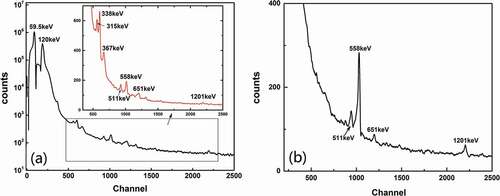
In this work, the quasi-hemispherical CdZnTe detector was fabricated to fully understand the performance in the mixed gamma–neutron detection field. The detector structure has been optimized based on the simulation. The objective energy resolution of fabricated quasi-hemispherical CdZnTe detector was <2% at 137Cs 662 keV for discriminating detection events of neutrons against those of gamma rays. By using 241Am, 57Co, and 137Cs radioactive source, the energy resolution and linearity of the detector were verified. The thermal neutron/gamma-ray discrimination of the detector around 241AmBe neutron field was investigated.
2. Materials and methods
The essential design parameters for the detector configuration are the physical dimensions, the electron structure, and the bias voltage. According to the literature [Citation19], the choice of the detector thickness is driven by the electron and hole mobility-lifetime of the crystals. In this study, physical dimension 10 × 10 × 5 mm3 of the CdZnTe crystal (μτ = 4 × 10−3 cm2/V) was used, software including Comsol, Geant4, and Matlab were employed to optimize the electrode structure and the bias voltage. shows the global simulation process. Comsol simulates the electrostatic field and weighting potentials within the detector volume and bias voltage. Geant4 are used to the initial interaction and the subsequent sub-interactions in the detector. Once an interaction ended, the list of energy deposition points is transferred as a parameter to the charge transport code. Then, Matlab used to calculate the carriers drift trace in the detector volume caused by the electrostatic and the induced current on the electrode which depend on the weighting potential. The final calculated induced charges on anode are accumulated to get the energy spectrum.
Cd0.9Zn0.1Te single crystal ingots offered from Imdetek Ltd. was sliced perpendicular to the growth direction into wafers. The surface damaged layer after slicing was removed by lapping, mechanical and chemo-mechanical polishing, and then chemically etched using 2% bromine methanol solution for 2 mins. For the quasi-hemispherical structure of detector, positive electrode pattern was fabricated using lithography technology and Au contact was prepared by vacuum evaporation. The other five negative contacts were electrochemically deposited from a solution of chloroauric acid. The performance and the pulse height spectra of the CdZnTe detector were examined using 241Am(100 μCi, 900 s count time), 57Co(100 μCi, 200 s count time), and 137Cs(20 μCi, 900 s count time) radiation source.
In order to validate the neutron detection ability, 5 Ci 241AmBe neutron source was placed in front of CdZnTe detector as shown in . The distance between the neutron source and the detector was 30 cm. A rectangle polyethylene with the thickness of 7 cm was used to moderate fast neutrons in front of the detector. The CdZnTe detector with the charge sensitive preamplifier is housed in a cylindrical aluminum enclosure for the electromagnetic shielding. The shaping amplifier (50 gain and 1 μs shaping time) and multichannel analyzer (3000 s count time) were also used to get the energy spectrum. After the neutron experiment, an additional experiment was performed. The detector was well shielded in a lead house (10 cm thickness) and collected the energy spectrum for 7200 s to ensure that the observed gamma rays were indeed from the neutron capture reactions in CdZnTe detector.
3. Results and discussion
The isotope 113Cd with high thermal neutron absorption cross-section of 20600 b [Citation20] absorbs the neutron through the EquationEquation 1(1)
(1) . This process emits a large number of gamma photons, most of which have the energy of 558 keV (74%) [Citation21].
The thermal neutron absorption rate of Cd0.9Zn0.1Te crystal was calculated with the EquationEquation 2(2)
(2) [Citation22]:
where is the portion of incident neutrons did not react, ∑ is the macroscopic thermal neutron cross-section of the Cd0.9Zn0.1Te crystal [Citation23], x is the distance of the incident neutrons. As shown in ), 90% of the thermal neutron capture reactions occur within 0.5 mm thick layer from the surface of the detector. As the gamma photons are emitted isotropically, only one-half of them enter into the crystal, which means almost 37 photons per 100 captures have the chance of producing a count in the 558 keV peak. The gamma rays emitted from 113Cd(n,γ)114Cd neutron capture reaction are higher than 200 keV in most range, which is uniformly absorbed in CdZnTe detector [Citation24]. The gamma-ray interaction probability of Cd0.9Zn0.1Te crystal was calculated with EquationEquation 3
(3)
(3) [Citation24]:
where is the transmittance of gamma rays, σ = 1/R is the absorption coefficient, R is the mean free path, and x is the detector thickness, the result is shown in ). It can be seen that the photoelectric interaction probability of 558 keV gamma ray is 33% for 5 mm CdZnTe crystal. Then, 33%×37 = 12.2 will be the thermal neutron counting efficiency in full-energy peak counts per 100 captures. A complication in the calculation of detection efficiency is that not all of the 558 keV photons will produce a count in the 558 keV photo peak. This is because a certain fraction of them will be detected in coincidence with other photons emitted in the same cascade absorbed in the detector. However, this is a complex calculation. Instead, it is simply point out that 12.2% detection efficiency represents an upper limit.
Both the electrostatic and weighting fields within the detector affect the charge collection performance critically. Based on Shockly–Ramo theorem [Citation25], the induced charge Qi is given by the weighting potential. The change in the induced charge, ΔQi and the current i at an electrode caused by a charge q moving from x1 to x2 are given by
where V(x) is the weighting potential at position x. The total induced charge on the electrode is determined by the change of the weighting potentials. Applying a positive bias voltage 1 V to the anode and 0 V to the cathode, the weighting potentials were given by Comsol. It is immediately clear from that because the five sides of the cathode are at the same potential, the electrode geometry reduced the electric potential throughout most of the detector volume compared to the planar detector. The suppressed weighting potential of the quasi-hemispherical electrode geometry heavily weights the dependence of charge induction away from the hole transport which is the shortage of CdZnTe crystal.
Figure 4. The thermal neutron and gamma ray absorptivity of CdZnTe crystal (a) and the interaction probability of gamma rays between 10 and 800 keV for 5 mm CdZnTe crystal (b).
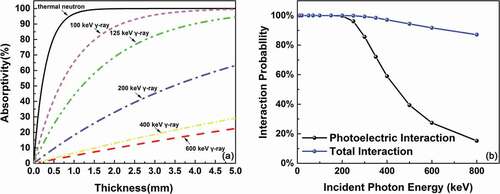
) shows the spectral performance for quasi-hemispherical CdZnTe detector with anode diameter between 1 and 3.5 mm. The results show that when D = 2.5 mm, the detector has an excellent performance that the energy resolution about 1.42% FWHM at 558 keV when 1500 V applied on both of the anode. The simulation results demonstrate that the anode diameter D should not be too small, such as shown in ) with D = 1 mm, the bad spectrum performance is mainly due to the weak statistic field caused by the small anode diameter. However, with D = 3.5 mm the spectrum also becomes worse, mainly because of the pixelated effect is not obvious caused by the large anode diameter. ) shows the simulated spectra of quasi-hemispherical CdZnTe detector with a D = 2.5 mm pixel anode at bias voltage between 1500 and 2500 V. Note that the peak resolution is good enough at 1500 V and is not obviously improved with the increase of bias voltage. Therefore, 1500 V bias was applied to all the experiments as an optimum voltage.
Figure 5. Slice plot of the weighting potential of planar (a) and quasi-hemispherical (b) electrode structure through the detector volume.
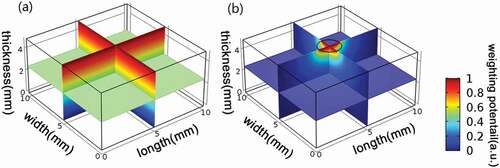
The pulse height spectrum stimulated by 137Cs gamma-ray source detected with the quasi-hemispherical detector is shown in ). The peak located at 662 keV has a FWHM of 10.91 keV, which is adequate for distinguishing 558 keV prompt gamma-ray from background gamma-ray, such as 59.5 keV 241Am decay gamma-ray and positron annihilation gamma-ray at 511 keV. The gamma-ray energy spectra with 241Am at 59.5 keV ()), 57Co at 122 and 136 keV ()) were also measured to calibrate CdZnTe spectrometer. The corresponding positions of 59.5, 122, 136, and 662 keV peaks are located at 107, 223, 250, and 1216 channel, respectively. A linear relationship of the energy positions with spectrum channels is obtained, as shown in ). The counting rates are 98.72, 1114.44, and 1056.81 cps for 137Cs, 241Am, and 57Co, respectively. It demonstrates that the quasi-hemispherical configuration of CdZnTe detectors is effective for the precise energy detection from 59.5 to 662 keV.
Figure 6. Gamma ray at 558 keV spectral performance for quasi-hemispherical CdZnTe with different pixel sizes (a) and with different anode voltages (b).
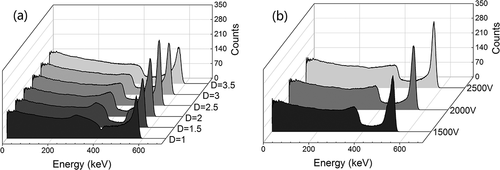
The pulse height spectrum obtained from 241AmBe source without the lead house is shown in ), and all of the peaks appeared in the spectrum were summarized in . 241Am decay gamma peak at 59.5 keV can be seen clearly. The peak located at 120 keV is the true coincidence summing (TCS). TCS effect for gamma rays occurs simply when two gamma photons are emitted in coincidence from the decay of the same nuclide, and they are recorded simultaneously within the resolving time of the detector [Citation26]. The enlarged part from 500 to 2500 channel is given in the illustration in ). Gamma-ray peaks located at 315, 338, and 367 keV are recorded, which could be attributed to the inelastic neutron scattering. The positron annihilation peak at 511 keV and the double escape peak at 1201 keV caused by 2.2 MeV hydrogen neutron capture gamma-ray are observed. Apart from the background gamma rays, we also found 113Cd(n,γ)114Cd neutron capture reaction gamma rays at 558 and 651 keV. The energy resolution for gamma-ray was determined to be 14.28 keV FWHM at 558 keV, which is adequate to distinguish between neutron and background gamma rays events. The count rate at 558 keV peak is 1.25 cps and we reasoned that the thermal neutron flux is at least 1.25 ÷ 12.2% = 10.24 n/cm2·s, where 12.2% is the maximum detection efficiency calculated above. This suggests that the 7 cm rectangle polyethylene is not enough to moderate fast neutrons. The spectrum of the detector shielded with the lead house is shown in ). The peaks at 558 and 651 keV still exist. The lead shielding reduces the background gamma rays while allowing a large percentage of the thermal neutrons to pass through. Hence, the peaks were attributed to the neutron capture reaction of 113Cd(n,γ)114Cd. From the discussions above, we can find that the quasi-hemispherical CdZnTe detector is able to discriminate the neutron events under high dose gamma-ray background conditions and simultaneously register neutron and gamma events, especially with relatively low energy gamma rays (<558 keV). The quasi-hemispherical CdZnTe detector may meet some demand to measure and distinguish gamma and neutron radiation, simultaneously. For example, Boron neutron capture therapy is based on high linear energy transfer radiation released from the neutron capture reaction 10B(n,α)7Li, in which a prompt gamma photon of 478 keV is emitted with a probability of 94% [Citation27,Citation28]. Such an arrangement could be used to determine the optimal time to start the patient treatment as real-time monitoring of the development of the boron distribution in the tumor and healthy tissues would be possible.
Table 1. Summary of peaks appeared in the spectrum shown in
4. Conclusion
The quasi-hemispherical CdZnTe detector was fabricated successfully. Based on the simulation, dependence of the performance of the CdZnTe detector on anode pixel diameter and bias voltage has been investigated. By using 241Am, 57Co, and 137Cs gamma-ray sources, the detector with optimum parameters reveals good energy resolutions, indicating the effectiveness of the quasi-hemispherical CdZnTe detector for precise energy detection from 59.5 to 662 keV. By using 241AmBe neutron source, neutron and gamma events were simultaneously detected with a good spectrometric performance at room temperature. The energy resolution for neutron capture gamma rays was determined to be 14.28 keV FWHM at 558 keV. The results indicate that the quasi-hemispherical CdZnTe detector could be used in the mixed gamma–neutron detection field.
Acknowledgments
Neutron irradiation of CdZnTe detector was performed at the Second Ship Design and Research Institution of WuHan. This work has been financially supported by National Natural Science Foundations of China (Nos 51502244, U1631116 and 51372205), National Key Research and Development Program of China (2016YFF0101301 and 2016YFE0115200). It is also supported by the Natural Science Basic Research Plan in Shaanxi Province of China (2016KJXX-09) and the Fundamental Research Funds for the Central Universities (3102015BJ(II)ZS014).
Disclosure statement
No potential conflict of interest was reported by the authors.
References
- Sundelin R, Edelstein R, Suzuki A, et al. Asymmetry of Neutrons from Muon Caputre in Silicon, Sulfur, and Calcium. Phys Rev Lett. 1968;20(21):1201.
- Beaumont S, Bertin R, Booth C, et al. GaAs solid state detectors for physics at the LHC. IEEE Trans Nucl Sci. 1993;40:1225.
- Coleman R. The application of neutron activation analysis to forensic science. J Forensic Sci Soc. 1966;6(1):19–27.
- Ruddy FH, Dulloo AR, Congedo TV, et al., inventors; US Patent, assignee. Monitoring of neutron and gamma radiation1999.
- Kania D, Lane S, Jones B, et al. High speed detection of thermonuclear neutrons with solid state detectors. IEEE Trans Nucl Sci. 1988;35(1):387–388.
- Hennings-Yeomans R, Akerib D. A neutron multiplicity meter for deep underground muon-induced high-energy neutron measurements. Nucl Instrum Methods Phys Res A. 2007;574(1):89–97.
- Knoll GF. Radiation detection and measurement. New York: John Wiley & Sons; 2010.
- Henzlova D, Kouzes R, McElroy R, et al. Current status of helium-3 alternative technologies for nuclear safeguards. Nat. Nucl. Secur. Administration, U.S. Dept. Energy, Euratom Atomic Energy Community (Euratom), Ispra, Italy, Tech. Rep.; 2015.
- Bell ZW, Carpenter DA, Cristy SS, et al. Neutron detection with cryogenics and semiconductors. Phys Status Solidi C. 2005;2(5):1592–1605.
- McGregor DS, Klann RT, Sanders JD, et al. Recent results from thin-film-coated semiconductor neutron detectors. X-Ray Gamma-Ray Detectors Appl IV. 2003;4784:164–183.
- McGregor DS, Bellinger SL, Fronk RG, et al. Development of compact high efficiency microstructured semiconductor neutron detectors. Radiat Phys Chem. 2015;116:32–37.
- McGregor D, Lindsay J, Olsen R. Thermal neutron detection with cadmium1− x zincx telluride semiconductor detectors. Nucl Instrum Methods Phys Res A. 1996;381(2–3):498–501.
- Martin-Martin A, Iniguez MP, Luke PN, et al. Evaluation of CdZnTe as neutron detector around medical accelerators. Radiat Prot Dosimetry. 2009;133(4):193–199.
- Brown S, Boucher Y, Mann J, et al. Thermal neutron source location using a 3-D position-sensitive CdZnTe detector array. Nuclear Science Symposium and Medical Imaging Conference (NSS/MIC), 2013 IEEE. Seoul, South Korea; 2013:1–5.
- Crane T, Baker M. Neutron detectors in passive nondestructive assay of nuclear materials. Los Alamos: Los Alamos National laboratory; 1991.
- Ivanov V, Aleksejeva L, Dorogov P, et al., editors. CZT quasi-hemispherical detectors with improved spectrometric characteristics. Nuclear Science Symposium Conference Record (NSS/MIC); Orlando (FL); 2009 IEEE.
- Bale DS, Franks LA, Szeles C, et al. Design of high-performance CdZnTe quasi-hemispherical gamma-ray CAPture plus detectors. SPIE Proceedings; San Diego (CA); 2006;6319:63190B.
- He Z. Review of the Shockley–Ramo theorem and its application in semiconductor gamma-ray detectors. Nucl Instrum Methods Phys Res A. 2001;463(1–2):250–267.
- Szeles C, Bale D, Grosholz J Jr, et al. Fabrication of high performance CdZnTe quasi-hemispherical gamma-ray CAPture™ plus detectors. Proc SPIE. 2006;6319:631909.
- Mughabghab SF. Neutron cross sections: neutron resonance parameters and thermal cross sections part B: Z= 61-100. Vol. 1. Cambridge: Academic press; 2012.
- Mheemeed A, Schreckenbach K, Barreau G, et al. The level structure of 114Cd from (n, γ) and (d, p) studies. Nucl Phys A. 1984;412(1):113–140.
- McGregor D, Vernon S, Gersch H, et al. Self-biased boron-10 coated high-purity epitaxial GaAs thermal neutron detectors. IEEE Trans Nucl Sci. 2000;47(4):1364–1370.
- Chadwick M, Herman M, Obložinský P, et al. ENDF/B-VII. 1 nuclear data for science and technology: cross sections, covariances, fission product yields and decay data. Nucl Data Sheets. 2011;112(12):2887–2996.
- Zha G, Wang T, Xu Y, et al. The development of CZT semiconductor X-ray and g-ray detectors. Physics. 2013;12:007.
- Shockley W. Currents to conductors induced by a moving point charge. J Appl Phys. 1938;9(10):635–636.
- Dryák P, Kovář P. Table for true summation effect in gamma-ray spectrometry. J Radioanal Nucl Chem. 2009;279(2):385–394.
- Winkler A, Koivunoro H, Reijonen V, et al. Prompt gamma and neutron detection in BNCT utilizing a CdTe detector. Appl Radiat Isot. 2015;106:139–144.
- Manabe M, Sato F, Murata I. Basic detection property of an array-type CdTe detector for BNCT–SPECT–measurement and analysis of anti-coincidence events. Appl Radiat Isot. 2016;118:389–394.

